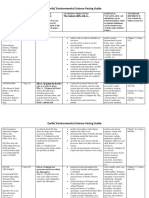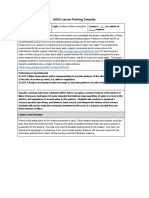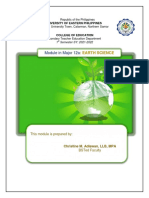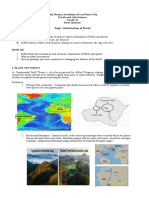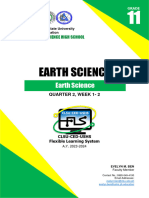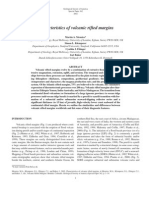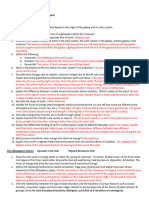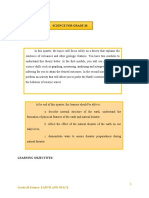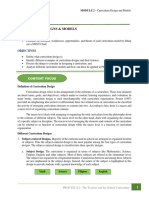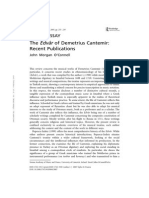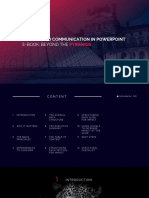0 ratings0% found this document useful (0 votes)
64 viewsMapping Volcano Lesson Plan
Mapping Volcano Lesson Plan
Uploaded by
api-361731639This lesson plan template provides details for a 3rd-5th grade lesson that is part of a 7-lesson series about a mission to Mars. The lesson focuses on examining the surface features of Mars, such as volcanoes and water ice deposits, to help students understand why landing on Mars is scientifically important and to determine safe landing sites. Students will analyze data about Martian volcanoes, make observations and measurements of a model volcano, and create a map of potential landing regions. The lesson aligns with NGSS performance expectations around observing the effects of weathering and interpreting maps of Earth's features.
Copyright:
© All Rights Reserved
Available Formats
Download as PDF, TXT or read online from Scribd
Mapping Volcano Lesson Plan
Mapping Volcano Lesson Plan
Uploaded by
api-3617316390 ratings0% found this document useful (0 votes)
64 views2 pagesThis lesson plan template provides details for a 3rd-5th grade lesson that is part of a 7-lesson series about a mission to Mars. The lesson focuses on examining the surface features of Mars, such as volcanoes and water ice deposits, to help students understand why landing on Mars is scientifically important and to determine safe landing sites. Students will analyze data about Martian volcanoes, make observations and measurements of a model volcano, and create a map of potential landing regions. The lesson aligns with NGSS performance expectations around observing the effects of weathering and interpreting maps of Earth's features.
Original Title
mapping volcano lesson plan
Copyright
© © All Rights Reserved
Available Formats
PDF, TXT or read online from Scribd
Share this document
Did you find this document useful?
Is this content inappropriate?
This lesson plan template provides details for a 3rd-5th grade lesson that is part of a 7-lesson series about a mission to Mars. The lesson focuses on examining the surface features of Mars, such as volcanoes and water ice deposits, to help students understand why landing on Mars is scientifically important and to determine safe landing sites. Students will analyze data about Martian volcanoes, make observations and measurements of a model volcano, and create a map of potential landing regions. The lesson aligns with NGSS performance expectations around observing the effects of weathering and interpreting maps of Earth's features.
Copyright:
© All Rights Reserved
Available Formats
Download as PDF, TXT or read online from Scribd
Download as pdf or txt
0 ratings0% found this document useful (0 votes)
64 views2 pagesMapping Volcano Lesson Plan
Mapping Volcano Lesson Plan
Uploaded by
api-361731639This lesson plan template provides details for a 3rd-5th grade lesson that is part of a 7-lesson series about a mission to Mars. The lesson focuses on examining the surface features of Mars, such as volcanoes and water ice deposits, to help students understand why landing on Mars is scientifically important and to determine safe landing sites. Students will analyze data about Martian volcanoes, make observations and measurements of a model volcano, and create a map of potential landing regions. The lesson aligns with NGSS performance expectations around observing the effects of weathering and interpreting maps of Earth's features.
Copyright:
© All Rights Reserved
Available Formats
Download as PDF, TXT or read online from Scribd
Download as pdf or txt
You are on page 1of 2
NGSS
Lesson Planning Template
th
Grade/ Grade Band: 3-5 grade Topic: Surface of Mars connection Lesson # __2__ in a series of _7___ lessons
Brief Lesson Description: The next step in the mission is to investigate the surface characteristics of Mars, evaluating potential science
research sites and associated landing regions. Research on Mars will tell us how that planet evolved over time and what physical processes
are at work both on Mars and Earth. Paramount to our research is locating current and past sources of water. Why water? The fundamental
requirements for life as we know it are liquid water, organic compounds and an energy source for synthesizing complex organic molecules
(https://mars.jpl.nasa.gov/msp98/why.html). So learning about water on Mars may give us clues about past or present Martian life. And
somewhere along the line Mars, which research tells us was much like Earth at its formation, lost all (or most) of its liquid water. This
lesson engages students in examining the surface features of rocky planets (Earth and Mars). Features will help students understand why a
mission to Mars is a viable endeavor (https://www.youtube.com/watch?v=5wiUU2RNvK0) .
Performance Expectation(s):
4-ESS2-1 Make observations and/or measurements to provide evidence of the effects of weathering or the rate of erosion by water, ice,
wind or vegetation.
4-ESS2-2 Analyze and interpret data from maps to describe patterns of Earths features.
Specific Learning Outcomes: Students will be able to recognize common features of the surface of Mars. Volcanoes, hydrogen-rich polar
deposits that indicate large quantities of water ice close to the surface, and signatures of ancient water on the surface. Students will
construct a model of a volcano, produce lava flows, and observe, draw, record, and interpret the history of the volcano. Students will
need to make the connection between the life cycle of a volcano and why they see these features on Mars.
Lesson Level Narrative
Where is the safest place for the mission personnel to land? What weather features and hazards would the team face when they finally
arrived? These are the types of questions that the team will need to answer in preparation for the landing. Your task is to map the possible
landing areas for the mission. Your team will describe the topography of volcanoes. Then, given certain surface features, will draw out a
map from the information gathered from Mars Global Surveyor and the Pathfinder missions.
Science & Engineering Practices: Disciplinary Core Ideas: Crosscutting Concepts:
Students will analyze and interpret data ESSD2.A: Earth Materials and Systems Patterns of change can be used to
about volcanoes on Mars and make a map Water systems help to shape the make predictions.
of their findings. land and affect the types of living Cause and effect relationships are
things found in a region. Water, routinely identified, tested, and
ice, wind, and gravity break rocks, used to explain change.
soils, and sediments into smaller
particles.
ESS2.B: Plate Tectonics and Large-Scale
Systems Interactions
The locations of mountain ranges,
deep ocean trenches, ocean floor
structures, earthquakes and
volcanoes occur in patterns. Most
earthquakes and volcanoes occur
in bands that are often along the
boundaries between continents
and oceans. Major mountain
chains form inside continents or
near their edges. Maps can help
locate the different land and
water features areas of Earth.
Possible Preconceptions/Misconceptions:
Students of all ages may hold the view that Earth and Mars are not dynamic, that they have always been like they are in the current era. Or,
that changes that have occurred must have been sudden and comprehensive (Freyberg, P. (1985). Implications across the curriculum. In
Osborne, R. (Ed.), Learning in science(pp. 125-135). Students can have different views of the dynamics of the earth with direct instruction
and investigation of the topic. Moreover, younger students who engage in modeling and map reading about Earth and Volcano topography
may lead students to construct coherent explanations about the causes of volcanoes(Duschl, R., Smith, M., Kesidou, S., Gitomer, D.,
Schauble, L. (1992). Assessing student explanations for criteria to format conceptual change learning environments .
LESSON PLAN 5-E Model
ENGAGE: Opening Activity Access Prior Learning / Stimulate Interest / Generate Questions:
Opening questions:
What can we expect to experience when we get to Mars? What is the weather like? What is the best place to land and what can
we tell about the conditions of Mars from the observations that have been made from the unmanned missions?
What do you think we need to know about Mars before we land?
EXPLORE: Lesson Description What should the teachers ask and do? What will the students do?
.
EXPLAIN: Concepts Explained and Vocabulary Defined:
Vocabulary:
ELABORATE: Applications and Extensions:
EVALUATE:
Formative Monitoring (Questioning / Discussion):
Summative Assessment (Quiz / Project / Report):
Elaborate Further / Reflect: Enrichment:
You might also like
- Ees Pacing Guide Fall 2016Document13 pagesEes Pacing Guide Fall 2016api-323312952No ratings yet
- Continuum 2014Document2 pagesContinuum 2014api-198803582100% (1)
- Counselor Competencies Scales CCS-RDocument7 pagesCounselor Competencies Scales CCS-Ragnes windramNo ratings yet
- Lessontemplates2 6Document6 pagesLessontemplates2 6api-362257789No ratings yet
- Science Grade 4Document22 pagesScience Grade 4Jocel MalonesNo ratings yet
- GEOS2114-2914: Volcanoes, Hot Rocks & MineralsDocument21 pagesGEOS2114-2914: Volcanoes, Hot Rocks & MineralsRoffy Aditya LimbaNo ratings yet
- Michael NewsViews Nature 2011Document2 pagesMichael NewsViews Nature 2011eepoporkaaNo ratings yet
- K-12 Science Curriculum Grade 10 Earth and Space: Edited By: Jevy Dacunes-CarbonquilloDocument65 pagesK-12 Science Curriculum Grade 10 Earth and Space: Edited By: Jevy Dacunes-CarbonquilloMark Jesson DatarioNo ratings yet
- Denudation A Geographical PerspectiveDocument10 pagesDenudation A Geographical Perspectiveshaurya301355No ratings yet
- Science 10 ModuleDocument21 pagesScience 10 ModuleGregorio Rizaldy100% (1)
- Science 10 (W1)Document21 pagesScience 10 (W1)Gregorio Rizaldy100% (1)
- Ch.7-1 Forces That Change The Earths SurfacesDocument23 pagesCh.7-1 Forces That Change The Earths SurfacesMyla Balingit AdiNo ratings yet
- PHYSICAL-GEOLOGYDocument13 pagesPHYSICAL-GEOLOGYKendric RodriguezNo ratings yet
- Module in Earth and Life ScienceDocument20 pagesModule in Earth and Life ScienceKenjie SobrevegaNo ratings yet
- When Earth got pummeled The frequency of impacts on Earth’s surface increased about 290 million years ago (Christian Koeberl, 2019, 2p, Science)Document3 pagesWhen Earth got pummeled The frequency of impacts on Earth’s surface increased about 290 million years ago (Christian Koeberl, 2019, 2p, Science)polNo ratings yet
- Module 5 - The Changing EarthDocument47 pagesModule 5 - The Changing EarthMa. Shantel CamposanoNo ratings yet
- Earth and Life Science September 20 - October 1 (Ortiz)Document9 pagesEarth and Life Science September 20 - October 1 (Ortiz)earlwilliam.ortizNo ratings yet
- Science 10 q1 NotesDocument7 pagesScience 10 q1 Notesalyn63292No ratings yet
- Stratified RocksDocument26 pagesStratified RockschealandNo ratings yet
- 4 Deformation of RocksDocument7 pages4 Deformation of RocksPaul Elijah SobejanaNo ratings yet
- ES Study Guide - Lesson13-Formation-and-Dating-of-RocksDocument9 pagesES Study Guide - Lesson13-Formation-and-Dating-of-RocksFrancine Yzabelle FugosoNo ratings yet
- USHS Module 1 Q2 Earth Science 2023 2024Document26 pagesUSHS Module 1 Q2 Earth Science 2023 2024Gianne Louise SilvestreNo ratings yet
- ADLC Science 8 - Fresh & Saltwater Systems PDFDocument38 pagesADLC Science 8 - Fresh & Saltwater Systems PDFLizaNo ratings yet
- REVIEWERDocument1 pageREVIEWERgalidofam36No ratings yet
- GHT-102 MMR Lecture-2 2020Document20 pagesGHT-102 MMR Lecture-2 2020Md. Mostafizur RahmanNo ratings yet
- Unit 2 Plate Tectonics: StructureDocument16 pagesUnit 2 Plate Tectonics: StructureSree Mallikarjuna Sevaa SadanNo ratings yet
- Grade 7 Earth and Space Science Earths CrustDocument2 pagesGrade 7 Earth and Space Science Earths Crustapi-239142091No ratings yet
- GeofinalsDocument23 pagesGeofinalsERNIE TILLAMANo ratings yet
- Science 10 - Quarter 1 - Week 6Document6 pagesScience 10 - Quarter 1 - Week 6nimadow299No ratings yet
- Science 10 ReviewerDocument4 pagesScience 10 Reviewerchoumain1995No ratings yet
- Lesson1 PDFDocument4 pagesLesson1 PDFApril Rose Arnuza RazonableNo ratings yet
- Gray Atkinson 2003Document6 pagesGray Atkinson 2003ArtinNo ratings yet
- Earth and Life Science Quarter 1 Week 5Document3 pagesEarth and Life Science Quarter 1 Week 5thessaeuste22No ratings yet
- Week 6 and 7 Reviewer For Quiz and ExamDocument5 pagesWeek 6 and 7 Reviewer For Quiz and ExamAljay AndradeNo ratings yet
- Plate TectonicsDocument1 pagePlate Tectonicsr dNo ratings yet
- Earth and Life Science Handouts 2Document5 pagesEarth and Life Science Handouts 2marielbalitonNo ratings yet
- Earth and Life Science Module LESSON 4Document16 pagesEarth and Life Science Module LESSON 4tsukki •No ratings yet
- WLP Earth Scie Els Week 8 JlaDocument20 pagesWLP Earth Scie Els Week 8 Jlajohnlowell.adalidNo ratings yet
- EarthsurfaceDocument1 pageEarthsurfaceChareynel Ayuban RadañaNo ratings yet
- Volcanic Rifted Margins - Menzies Et Al 2002Document14 pagesVolcanic Rifted Margins - Menzies Et Al 2002Ken McDermottNo ratings yet
- Evolution of North Himalayan Gneiss Domes: Structural and Metamorphic Studies in Mabja Dome, Southern TibetDocument20 pagesEvolution of North Himalayan Gneiss Domes: Structural and Metamorphic Studies in Mabja Dome, Southern Tibetswagat karNo ratings yet
- Oceanography 1Document20 pagesOceanography 1fernandez.harveyjoshNo ratings yet
- LAS in Earth and Life Science (W5C3) - 1Document8 pagesLAS in Earth and Life Science (W5C3) - 1Ronald ArtilleroNo ratings yet
- Science-8-Q2-Week-3Document10 pagesScience-8-Q2-Week-3jenny.wanget89No ratings yet
- 362 Volcanic Rifted MarginsDocument231 pages362 Volcanic Rifted MarginsEdwin Yudha NugrahaNo ratings yet
- Reflection Journal 3 - GENSCI 601-2ndSEM2024Document2 pagesReflection Journal 3 - GENSCI 601-2ndSEM2024Aspiah AndamNo ratings yet
- Slemmons&dePolo 1986Document19 pagesSlemmons&dePolo 1986cesar garcia jr.No ratings yet
- Time and Space Scales: Coastal ClimateDocument5 pagesTime and Space Scales: Coastal ClimateÁlvaro Pérez-PérezNo ratings yet
- Bachkhoathudiachat - A TNG HCDocument5 pagesBachkhoathudiachat - A TNG HCnguyenhoa090503No ratings yet
- Plate TectonicsDocument4 pagesPlate TectonicsGargi YadavNo ratings yet
- Alabaugh Earth Science NC Final ExamDocument4 pagesAlabaugh Earth Science NC Final ExamraschorzmanNo ratings yet
- 1 s2.0 S0895981121002133 MainDocument20 pages1 s2.0 S0895981121002133 MainOMAR AIT HADDOUNo ratings yet
- Details of Module and Its StructureDocument11 pagesDetails of Module and Its StructureGARIMA VISHNOINo ratings yet
- Geological and GeophysicalDocument5 pagesGeological and GeophysicalPrincess Morales TyNo ratings yet
- Volcanic and Tectonic Processes and LandformsDocument10 pagesVolcanic and Tectonic Processes and LandformsI Nyoman SutyawanNo ratings yet
- Els ReviewerDocument2 pagesEls ReviewerKathleen Kaye Delos AngelesNo ratings yet
- Earth Science 1Document20 pagesEarth Science 1Christine Cloe NugoyNo ratings yet
- Cembrano y Lara, 2009 PDFDocument15 pagesCembrano y Lara, 2009 PDFCarolina Zapata MelladoNo ratings yet
- Science For Grade 10 (1ST Quarter Module)Document85 pagesScience For Grade 10 (1ST Quarter Module)Norigen ItangNo ratings yet
- Valentine SlidesCarnivalDocument4 pagesValentine SlidesCarnivalnaomiNo ratings yet
- Geology Activity 1Document6 pagesGeology Activity 1Angelica JugoNo ratings yet
- MODULE 2 - The Teacher & The CurriculumDocument23 pagesMODULE 2 - The Teacher & The CurriculumBob FloresNo ratings yet
- Hay Group Surveys - Emotional & Social Competency InventoryDocument6 pagesHay Group Surveys - Emotional & Social Competency InventoryShodeneNo ratings yet
- Teaching ResumeDocument3 pagesTeaching Resumeapi-314677174No ratings yet
- Silent Reading 1Document4 pagesSilent Reading 1api-278024645No ratings yet
- Mohd Anuwi Bin Husain Dr. Mat Ali Bin Abdul GhaniDocument9 pagesMohd Anuwi Bin Husain Dr. Mat Ali Bin Abdul GhanisakinahNo ratings yet
- OPT B1 T2M Unit 9 WorksheetDocument1 pageOPT B1 T2M Unit 9 Worksheetfabian palma vazquesNo ratings yet
- PDFDocument5 pagesPDFerbariumNo ratings yet
- OST Report 2022 Template V2apr2022Document18 pagesOST Report 2022 Template V2apr2022Vinny MNo ratings yet
- Curriculum Vitae (Fuerzas)Document2 pagesCurriculum Vitae (Fuerzas)James Andrew F. FuerzasNo ratings yet
- Enclosure No. 4 To DM Sgod No. 022 S. 2022 Sip Standard OutlineDocument25 pagesEnclosure No. 4 To DM Sgod No. 022 S. 2022 Sip Standard OutlineAlyssa Grace Dela TorreNo ratings yet
- FLTC A1-TapoDocument2 pagesFLTC A1-TapoSP GayonNo ratings yet
- ISA Sample Maths G7-10Document14 pagesISA Sample Maths G7-10Rosa Rosa100% (1)
- General Instructions (Written Examination-Interview) UPDATED ON 05-10-2021Document6 pagesGeneral Instructions (Written Examination-Interview) UPDATED ON 05-10-2021Farooq KhanNo ratings yet
- De On Thi Vao Lop 10 Chuyen Ngoai NguDocument6 pagesDe On Thi Vao Lop 10 Chuyen Ngoai NguMKNo ratings yet
- Phil IRI FormDocument6 pagesPhil IRI FormJanineQuiambaoYabutNo ratings yet
- Typical Interview Questions and Best ResponsesDocument5 pagesTypical Interview Questions and Best ResponsesinnovatorinnovatorNo ratings yet
- Ncetm Primary Magazine Issue 13Document17 pagesNcetm Primary Magazine Issue 13AndaiDapat Ku UndurMasaNo ratings yet
- Cover LetterDocument19 pagesCover LetterAhmed M AminNo ratings yet
- Individual Daily Log and Accomplishment Report (IDLAR)Document2 pagesIndividual Daily Log and Accomplishment Report (IDLAR)felina.ting1975No ratings yet
- Competency ProfileDocument2 pagesCompetency ProfileAli Haider67% (3)
- Activity Sheetactivity Sheet: Taxonomy of Educational ObjectivesDocument14 pagesActivity Sheetactivity Sheet: Taxonomy of Educational ObjectivesAaron Christopher SungaNo ratings yet
- !1-ОШ TС Англ.яз 5кл англ 300318Document49 pages!1-ОШ TС Англ.яз 5кл англ 300318Айдана КонаковаNo ratings yet
- Structured Communication in PowerpointDocument46 pagesStructured Communication in PowerpointAHMED YOUSEF100% (1)
- Burger King 2015 Annual ReportDocument30 pagesBurger King 2015 Annual Reportslezhummer0% (1)
- Do-Anytime Activities For Grade 2 PDocument2 pagesDo-Anytime Activities For Grade 2 Papi-308496721No ratings yet
- Ashlee Clare NSW C V 2Document3 pagesAshlee Clare NSW C V 2api-355253675No ratings yet
- Personal Development Worksheets WK 1 - 1Document7 pagesPersonal Development Worksheets WK 1 - 1Ana Maria Gerson TongcoNo ratings yet
- Civil Engineering Project Proposals: MembersDocument11 pagesCivil Engineering Project Proposals: Membersjesma lauditNo ratings yet
